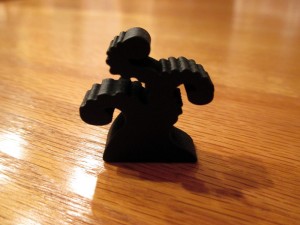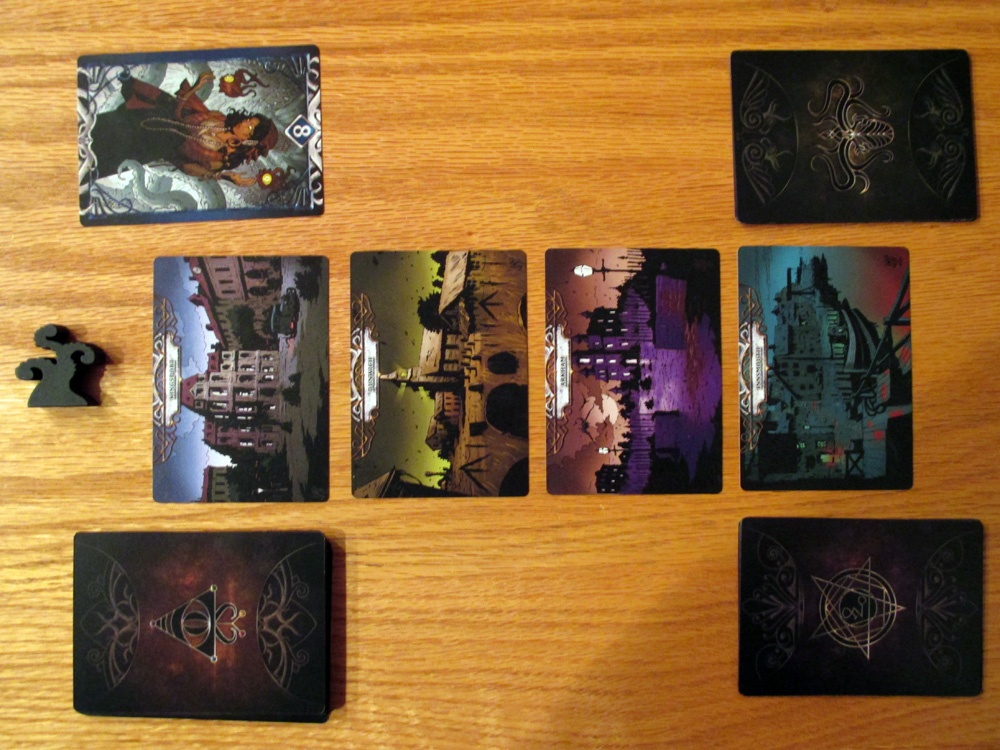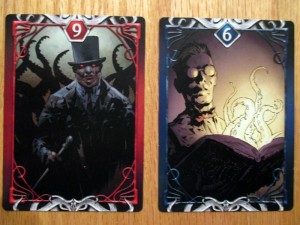 I can honestly say and prove that I am a Cthulhuaholic. Since high school I easily have read and owned over 50 works of fiction from H.P. and various authors on the mythos as well over a dozen board games and RPGs about this genre. I prefer games, RPGs, movies, clothes, etc. based on the mythos. I love the macabre and the Cthulhu mythos creep me out and horrify me like nothing else. So, when Rise of Cthulhu came into the Board Game Quest queue I jumped at the chance to review (and own) this game. This 2-player game comes from game designer and self-publisher Chuck D Yager. At first glance this game looks like a great way quench your Lovecraftian gaming fix but does it fit the genre and more importantly is it fun? Let’s find out!
I can honestly say and prove that I am a Cthulhuaholic. Since high school I easily have read and owned over 50 works of fiction from H.P. and various authors on the mythos as well over a dozen board games and RPGs about this genre. I prefer games, RPGs, movies, clothes, etc. based on the mythos. I love the macabre and the Cthulhu mythos creep me out and horrify me like nothing else. So, when Rise of Cthulhu came into the Board Game Quest queue I jumped at the chance to review (and own) this game. This 2-player game comes from game designer and self-publisher Chuck D Yager. At first glance this game looks like a great way quench your Lovecraftian gaming fix but does it fit the genre and more importantly is it fun? Let’s find out!
Rise of Cthulhu is a 2-player card game that uses the elements of hand management, set collection, and strategy. It takes about 25-30 minutes to play.
Game Overview:
Rise of Cthulhu is a 2-player card game where each player is a Cult Leader trying to end the game with the most influence (or point total depending on the Old One awakened). You select cards of numbered cultists and place them on a Location to gain influence. If you have influence, then the Location will face you. If you play Cultists and form sets you gain special cards that will influence you and your opponent’s play. Old Ones are shuffled in the Cultist Deck and are revealed or awakened as players draw cards. Once Old Ones are awakened, they need to be placed at a location and will lock it. When the last Old One is awakened, then the player with the most influence (or again points) wins.
Game Components:

The components that come with Rise of Cthulhu are of excellent quality. All the cards are cut well and are of quality stock so replay should not ware on them (though I would recommend card sleeves for any card game). The box is small, which makes the game very portable and quality made with a thick overlay so it’s durable. The game includes a deck of 5 different colors of numbered cultist cards 1-10 for a total of 50 cultist cards. It also includes the following: 4 location, 6 artifact, 8 monster, 6 Old Ones cards, 1 wooden Dark Hunter Token, and an illustrated rule book.
All the components are based on classic Lovecraftian locations, monsters, and use images that are all too familiar for even the casual Cthulhu fan. I have to say that the art on the cards and in the rule book fits the genre perfectly. It’s creepy, makes you uncomfortable, and makes you look twice and wince (yes, that book does have a tentacle coming out of it). The artist and the design team did a phenomenal job on these images and let me thank them for providing images to populate player nightmares.
How to Play:
To start the game, you’ll deal out the four location cards to the middle of the table between the two players. Each card should be positioned vertically so it appears neutral. Each player starts the game with 5 cultists cards. 3 Old Ones are randomly selected and shuffled into the Cultist Deck a regular intervals.
To play the game, each player has 2 actions. All action options are either: draw 2 cards, play 2 cards, or draw 1 and play 1 (in either order).
When you play a Cultist card, you will play it in front of 1 the 4 Location cards in the middle of table. If you have the higher Cultist total (again the Cultist cards are numbered 1-10), then you will gain influence and you will turn the location card to face you. When you play Cultists cards, you can acquire combinations which give you set abilities.
There are three set abilities:
• Play 3 Cultist cards of the same color and you may choose to move the Dark Hunter token back to its starting position.
• Play 3 Cultist cards of the same number and the player must draw a Monster card.
• Play 3 Cultist cards of the same color in numerical order, the player must draw an Artifact card. Please note that the Monster and Artifact Cards do not count as a play action.
When you draw you have two options: you can take a card from the Cultist Deck, or take the face-up Cultist in the Valley. If you play/discard to the Valley you must replace that Cultist card with a Cultist of higher value or of the same color. If you play/discard to the Valley, then you gain the ability to move the Dark Hunter token to one of the Location cards and destroy the highest Cultist card (beware this could be yours so place it wisely). New Cultist or Monster cards cannot be played on the Location that the Dark Hunter token is on.
As you draw from the Cultist Deck, an Old One card will be drawn and it’s “awakened.” It’s immediately played on the location indicated on the card and the player with influence on that location will benefit from the power text on the Old One card. Once the third Old One is played the game ends. The player with the most influence wins. If there is a tie or if the Old One Azathoth has awakened, then the player with the highest point total.

Game Experience:
Rise of Cthulhu is a slick game with easy, straight-forward rules. The game play is quick with two actions so players will not have down time waiting for their opponent. Within the two actions a classic premise emerges for players to figure out how best to out think their opponent to win. Additional elements such as the Dark Hunter token, Monster and Artifact decks bolster player options and strategy. These characteristics make this an ideal gateway game for non-gamers and still have plenty appeal for gamers alike.
While the premise is not original, the theme is a natural fit within Cthulhu genre. You’re a Cult Leader trying to awaken Old Ones as you can take control of 3 out of 4 classic Lovecraftian locations. Yes, it is a divergent path from the literature and games in that you’re not the good guy trying to stop the bad guy. You’re instead a bad guy trying to out-do another bad guy for a Dark God’s favor. What’s not to love about that?! Yes, it’s a dark theme but you will nonetheless take enjoyment trying to win like any other game. It’s pleasing as you destroy rival Cultists in an effort to gain influence all the while playing sets to summon Monsters, Artifacts, and the Dark Hunter to help you do your bidding (insert evil laugh).

The two main two strengths of Rise of Cthulhu are the replay value and the Valley mechanic. The variety of random Old One cards helps with extends the game experience each time you play. As long as you don’t randomly play the same three in the same order, you get a different game experience each time. The Old One powers vary widely as well as their Location placement and this will help make each game feel unique. The Monster decks and Dark Hunter token are nice addition if you can acquire or control them. These are equalizers in the game to help you and hinder your opponent and add to unique game experiences each time.
Elements of chance can be great, but only having elements of chance will frustrate any player at a given time. The options to draw and play to the Valley gives players something that they can control. This is a costly and powerful mechanic that adds to the game play. A player can draw a face up Cultist card and they can also play a higher or like color to the Valley. Again, you control your choices by selecting the Cultist card and can then control which card you may chose to play back to the Valley. This adds another level of strategy for both players because you might have taken a card your opponent wanted or you play a card that they might now need. And let’s not forget the best part, if you’re able to play to the Valley, you gain control and can move the Dark Hunter to a Location and destroy an opponent’s highest value Cultist. Once the Dark Hunter is placed, it stops the addition of any Cultists and Monsters to that Location until it is moved. This is a great mechanic that is not left to chance, that players control, and adds an excellent balance to the game.
Overall the game is solid but there’s one weakness that hurts game play and player strategy, which is the Artifact deck. The Silver Key is a great artifact but this is the only artifact included in the deck of six cards. All other decks have variety and are blind from the players except this one. Different artifacts are supposed to be coming in future expansions, but for now there’s no mystery when someone acquires an artifact. This genre is so rich with artifacts that a deck of unique artifact cards should have been a no brainer. Off the top of my head I can think of a few artifacts from the genre such as a Mi-Go Brain Cylinder, Lamp of Al-Hazred, Elder Sign, and of course the Necronomicon. Only getting the one artifact makes the card play become predictable especially after you play the game a number of times. The Silver Key typically becomes a deterrent for players to hold certain cards or get your opponent to use it because it destroys a card about to be played. If Azathoth is awakened during the game, player strategy could change because now it can also add to a player’s point total for that sort of win. Overall, this transparency and predictably hurt the game.
Final Thoughts:

I honestly I have more praise than issues with Rise of Cthulhu. This would be a great game to get non-gamers feet wet with the easy to learn rules and quick game play. This will also hold a gamers attention because of similar elements of from other games and of course attract gamers who like the unique theme and genre as well. At times you might misstep when first learning on what is considered a play or draw but nothing a few walk-throughs and a careful read of the 8 pages of rules and FAQ will not fix.
I think the one thing that I had to get used to as a gamer was the Valley. You can draw a card from the Valley but then you have to play a card back. So, yes, your turn is done unless you plan on moving the Dark Hunter. It took a few times to realize this used both actions but it makes sense because it’s a powerful option.
Familiarity with the Cthulhu Mythos isn’t required to enjoy Rise of Cthulhu. When I tested this game out with other players, this was the first comment of concern that they admittedly knew nothing of Cthulhu, Lovecraft, or the Mythos. The genre is what drew me in but it’s not essential to play Rise of Cthulhu.
The last thing to note is I look forward to the future expansions and these are just my opinions. The artifacts, of course, but also and hopefully additional Monster, Location, and Old One cards. There’s so much out there about this genre and Chuck D. Yager did a great first step, but I would like to see more cards to extend the replay and experience. I mentioned possible additions of the location cards but another Cultist color or two to possibly expand the game beyond a 2-player game to a 2-4 player experience would be ideal. The 2-player version is great but adding more players I think would add to the level of play and strategy. Yes, it will likely slow the game down but just like the 2-player version you need to pay attention and think of your next move.
If you’d like to try it out yourself, you can help fund it on kickstarter for $25.
Final Score: 4 Stars – A great 2-player gateway game that is both portable and a lot of fun to play. This one will have a home on my gaming shelf for a long time.
 Hits:
Hits:
• True to the genre
• Easy to learn rules
• Quick game play
• Unique Valley game mechanic
Misses:
• No variety with the Artifact Deck
• Game limited to two players






















I don’t know if you’ll see this after such a long time, but I just recently bought this game, and I thought I should point out a couple of fundamental errors in your explanation of the rules.
First, the Dark Hunter destroys the highest-ranking cultist at a location, period. (It even specifically states that if there’s a tie, one cultist from each side is destroyed.)
Secondly, you don’t have to play to the Valley in order to draw from the Valley, or vice versa. (And if you do play a card to the Valley, you MUST move the Dark Hunter; it’s not optional — though there’s no reason to play a card to the Valley unless you’re planning on doing that anyway.) There can be more than one card in the Valley (or none), and I found a statement by the author in the BGG forum that the Ghast card lets you choose any card from the Valley instead of just taking the top card.
Yeah, the designer pointed out the Valley mechanic after the review published. I thought I had fixed it but it still my be in question. Thanks for catching that error in the review.